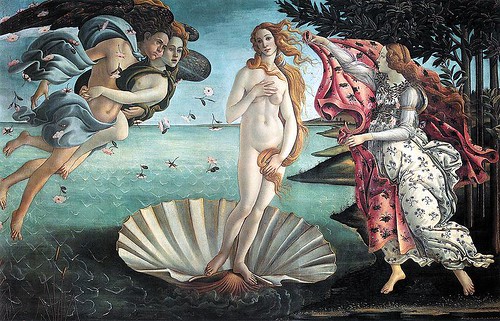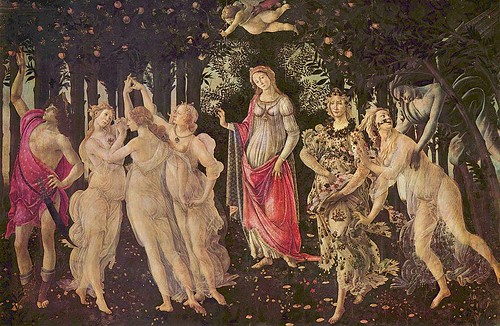The Birth of Venus was much easy to appreciate because of the incredibly elegance and beauty permeating from every inch of the large canvas.

Nascita di Venere (Birth of Venus), Sandro Botticelli
Here, a newly born goddess, goddess of love, beauty, pleasure and procreation, awakening from a trance, floating towards the shore on a giant seashell - a metaphor for a woman's vulva, in her beauty in full view, save for her hands, casually rested on some her breasts and thigh, inviting and indifferent to the worldly gaze. She was being framed by Zephyrus, God of Winds, carrying the gentle breeze Aura and together they blew the goddess ashore. The Horae, Goddess of the Seasons, waited to receive Venus and spreads out a flower covered robe in readiness for the Love Goddess' arrival.
Venus, known in Greek culture as Aphrodite, was born when young Titan Cronus cut off his father Uranus' genitals and threw them into the sea, and from the sea foam (aphros) arose Aphrodite.
She was the result of mating between cutoff male genitals and the ocean, or symbolize the interchangeable love symbol between male and female, at least in ancient Greek time.
But of course, in the early Renaissance time, Botticelli was more interested in a Neoplatonism view - which gained new currency during Renaissance time - of this ancient story.
For many of the Neoplatonists, the very vision of God was the contemplation of divine beauty in a state of erotic trance. Therefore, this very static and pallid female form, in her semi-consciousness state, was the apex of beauty and love. Viewed from a religious standpoint, the nudity of Venus also suggested Eve before the Fall as well as the pure love of Paradise. Once onshore, she was to don an earthly cloth which some argued that would symbolize the prefigure of Madonna. On her right was Zephyrus, God of Winds, carrying gentle breeze Aura, and together they blew her ashore. The Horae, Goddess of the Seasons, to her left, waited upon her while opening up a flowery robe to receive her.
Botticelli's style was not naturalism - his figures were airy and almost weightless. They were gentle winds. He was also not a slave to the correctness of human anatomy. His Venus, pale blonde, slender yet voluptuous, was an Italian Renaissance ideal.

Primavera (Spring), Sandro Botticelli
This Primavera was much more crowded and even more enigmatic. In the center of the painting was Venus, the goddess of love, with her slender head wedged in a halo of sky and trees, which amazingly resembled the pair of human lungs, thus granting the position of heart to the tilting head of Venus. The blindfolded flying Cupid above the trees, together with the lungs and Venus, invoked usual order of holy trinity.

United States public domain Source: Wikipedia
This work definitely again followed the reasoning of Neoplatonism - paganism and Christianity co-existed and complemented each other. The reference to trinity continued with the three dancing Graces - Pulchritude (Beauty), Castitas (Chastity) and Voluptas (Pleasure), together they had roughly the same shape as that formed by Cupid, the lungs and Venus.
To Venus's left, there were another triad - Zephyr (West wind), Chloris the nymph, and Flora, who heralded spring, bestowing lovely flowers about her.
To break the absolute symmetry, Botticelli included a resplendent young god Mercury to the far left of the painting, left to the three Graces, identifiable by his helmet, winged boots and his caduceus.
In other to bind these groups together, Botticelli lovingly employed repeating postures of many figures, thus creating an undulating rhythm gently rippling through the span, this also bound the individual groups into unity. One could see that Flora, Venus, two of the Graces, Mercury, and even Chloris, all leaned slightly towards canvas left, and because they didn't not stand on a single line, this created variations within unity. Particularly interesting to me was that Mercury was almost a copy of the Grace on the right, except for the positions of the legs. In the shaded woods, amongst pale skin tones, Venus's scarlet robe corresponded with the wine-colored one of Mercury's on the left, balancing the more complicated patterns on the right and ghostly skin tone of Zephyrs.
Once again, the beauty of these elongated figures were incredible, surely defined by the endless and endlessly changing rhythms of Botticelli's trademark lines.
My Favorite Museum Collection Series
>> My Favorite Museum Collection Series 17: My Favorite Paintings at Palatina Gallery, Palazzo Pitti, Firenze, Italia
<< My Favorite Museum Collection Series 15: My Favorite Artworks at the Galleria dell'Accademia Firenze





No comments:
Post a Comment